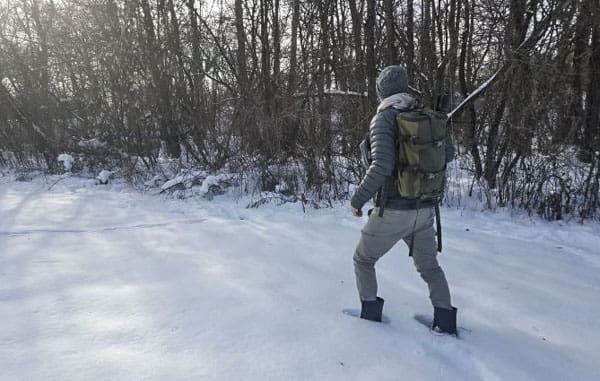
There’s one feature I prize above all in the gear I use; quality comes in the form of functional minimalism. I hate carrying more than I have to and as such I don’t often carry much. So I decided that I’d take on this last deer season with a single piece of gear… and ended up with a very functional multi-part system instead.
I contacted the folks at Hill People Gear to see about getting my hands on one of their kit bags. For those unaware of this classification of gear, a kit bag is essentially a chest-mounted, self-contained zippered pouch. It has a binocular-style harness and is fully adjustable.
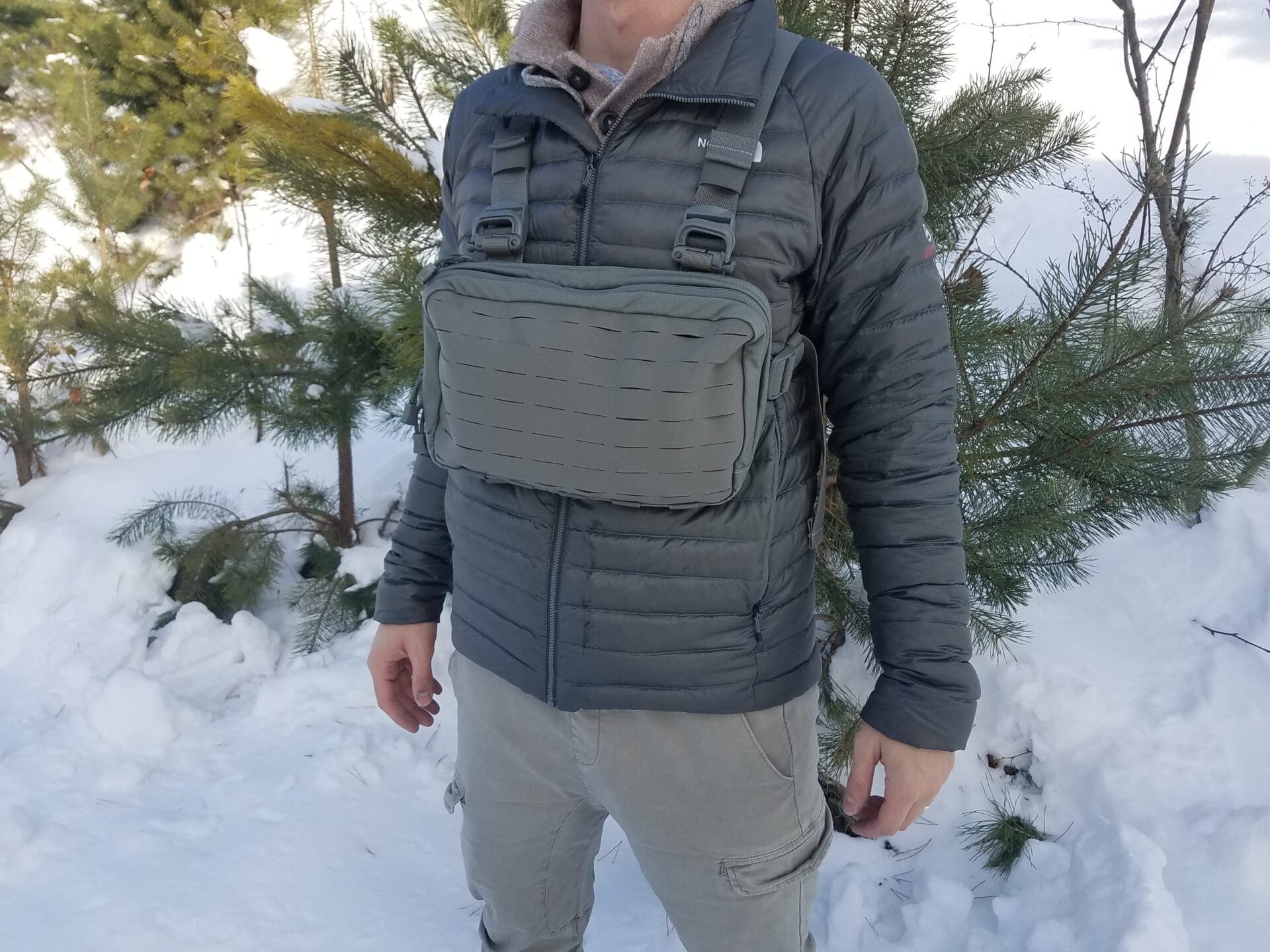
There are several varieties of these available from HPG. Some are small and smooth, while others are larger and have integrated webbing for accessory mounting. They have combinations that can fit any need and are truly multi-purpose.

The kit bag itself is spacious. The model I got was their Heavy Recon version. It was apparent upon inspection that this is one seriously well-made piece of gear. The stitching was entirely professional without a single loose thread.
The first time I wore it, though, I was a bit unsure of the overall utility. It didn’t take long before I was convinced.
With the pack mounted on my chest, there’s nothing I don’t have immediate access to. I wore it while practicing at the range and on walks and hikes. My total loadout with a snubbie inside weighed about five pounds. That may not seem like much, but even five pounds carried over ten miles gets heavy. But not so much using this remarkable little guy.
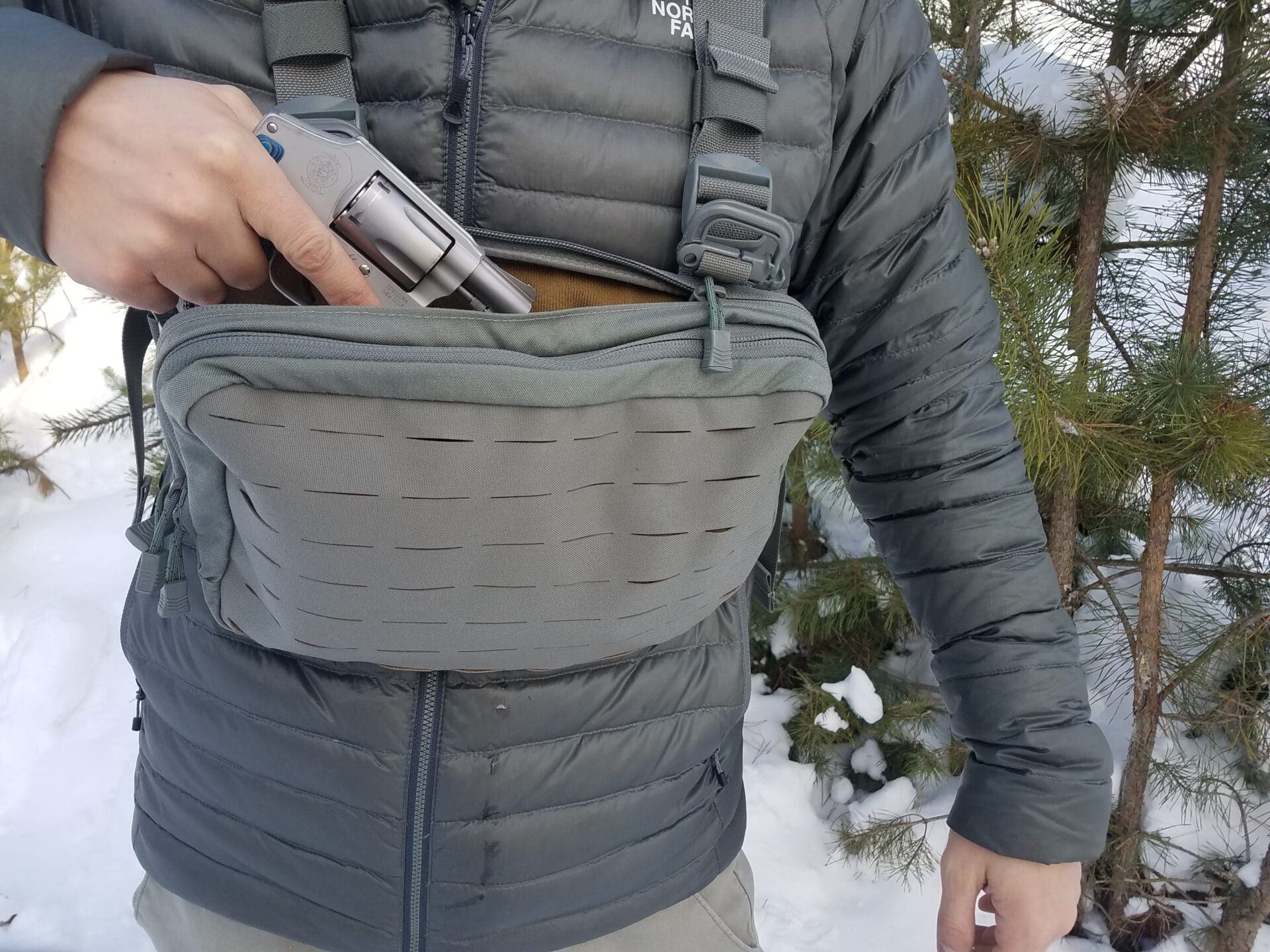
I discovered that I favored carrying the kit bag without gear mounted on the outside. When lying prone, anything strapped to the Heavy Recon was noticeable and a bit bumpy, so I opted to carry my AICS-pattern magazines on the inside when hunting.
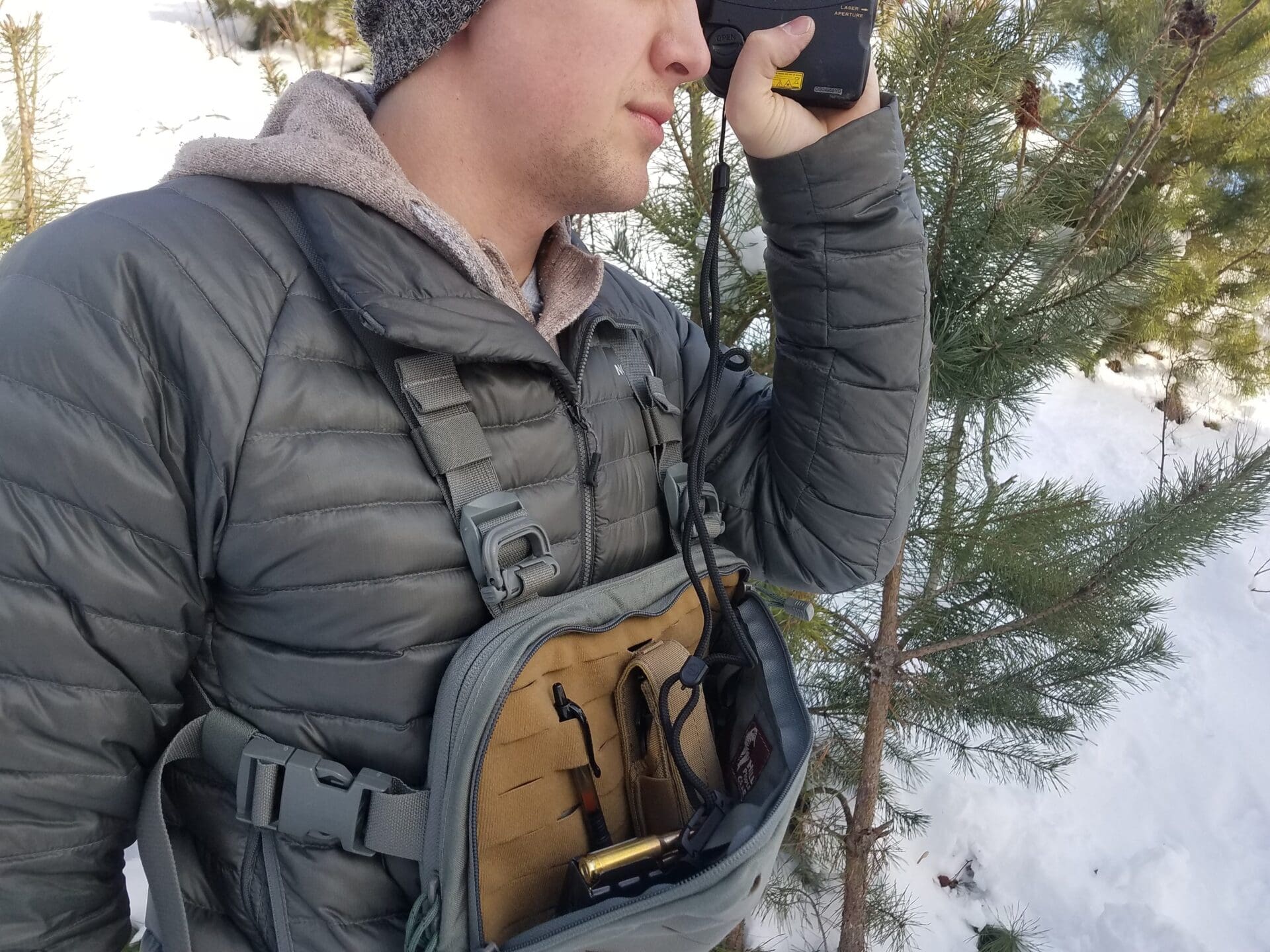
I began my season trying to limit myself in terms of gear as I’d grown tired of cumbersome packs and pouches on my walk-ins. I thought that the kit bag was going to be my one-and-only, but fate and Hill People managed to convince me otherwise.
Along with the Kit Bag, HPG sent what I can only describe as the most comfortable and functional backpack I’d had the pleasure of carrying.
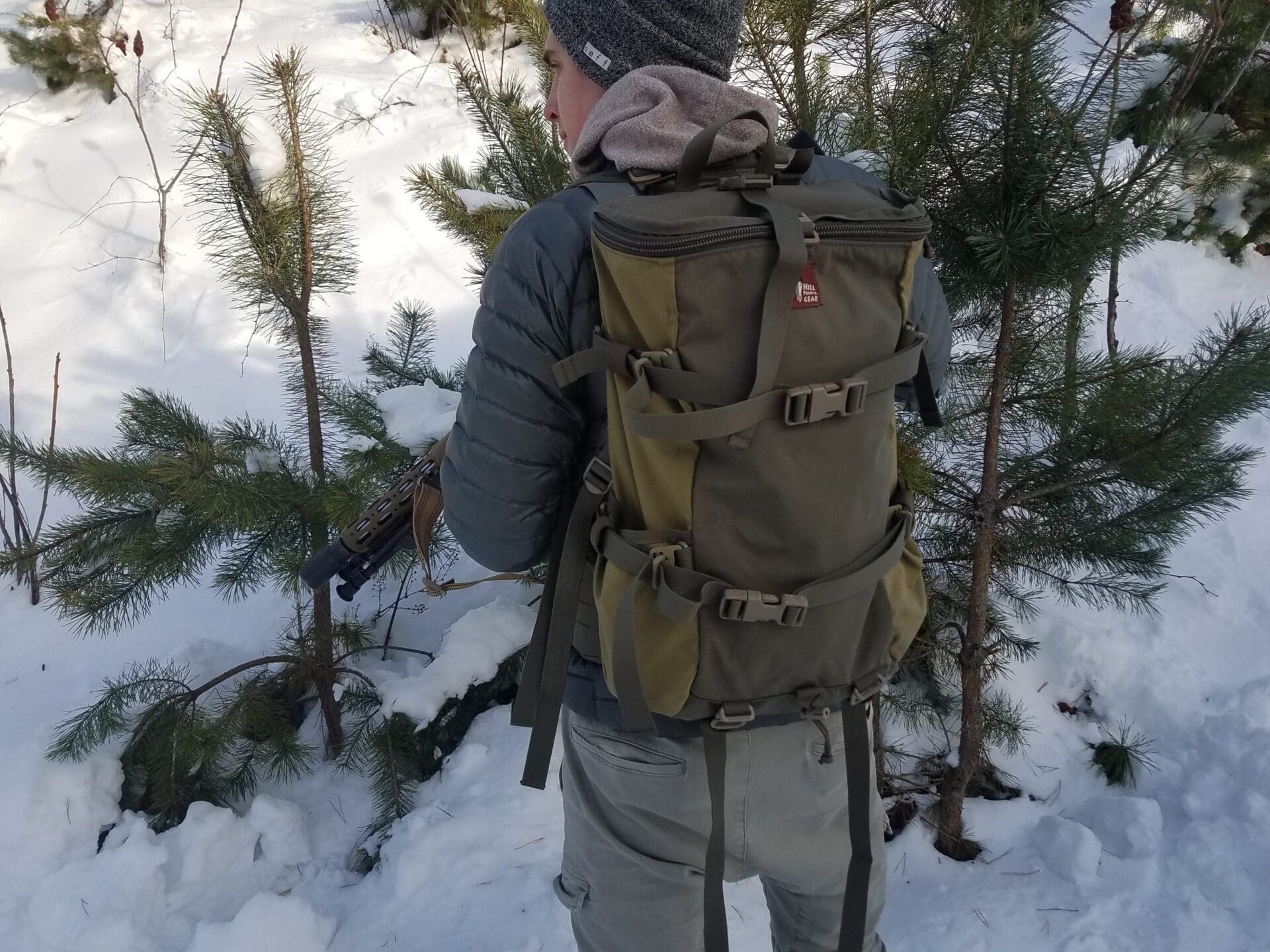
The Umlindi Pack was something that I wasn’t really interested in trying when I talked with Hill People. Backpacks were backpacks as far as I was concerned. But I couldn’t be any happier with it.
The sheer amount of adjustability the Umlindi affords is hard to list, but the fact that the pack was modular made it all that much sweeter. Included with the Umlindi was a removable padded belt with webbing. This belt also works as a standalone and is among the more comfortable battle belts I’ve tried over the years. There are two small hooks that extend from the Umlindi and attach to the sides of the belt to integrate it and help bear the load.
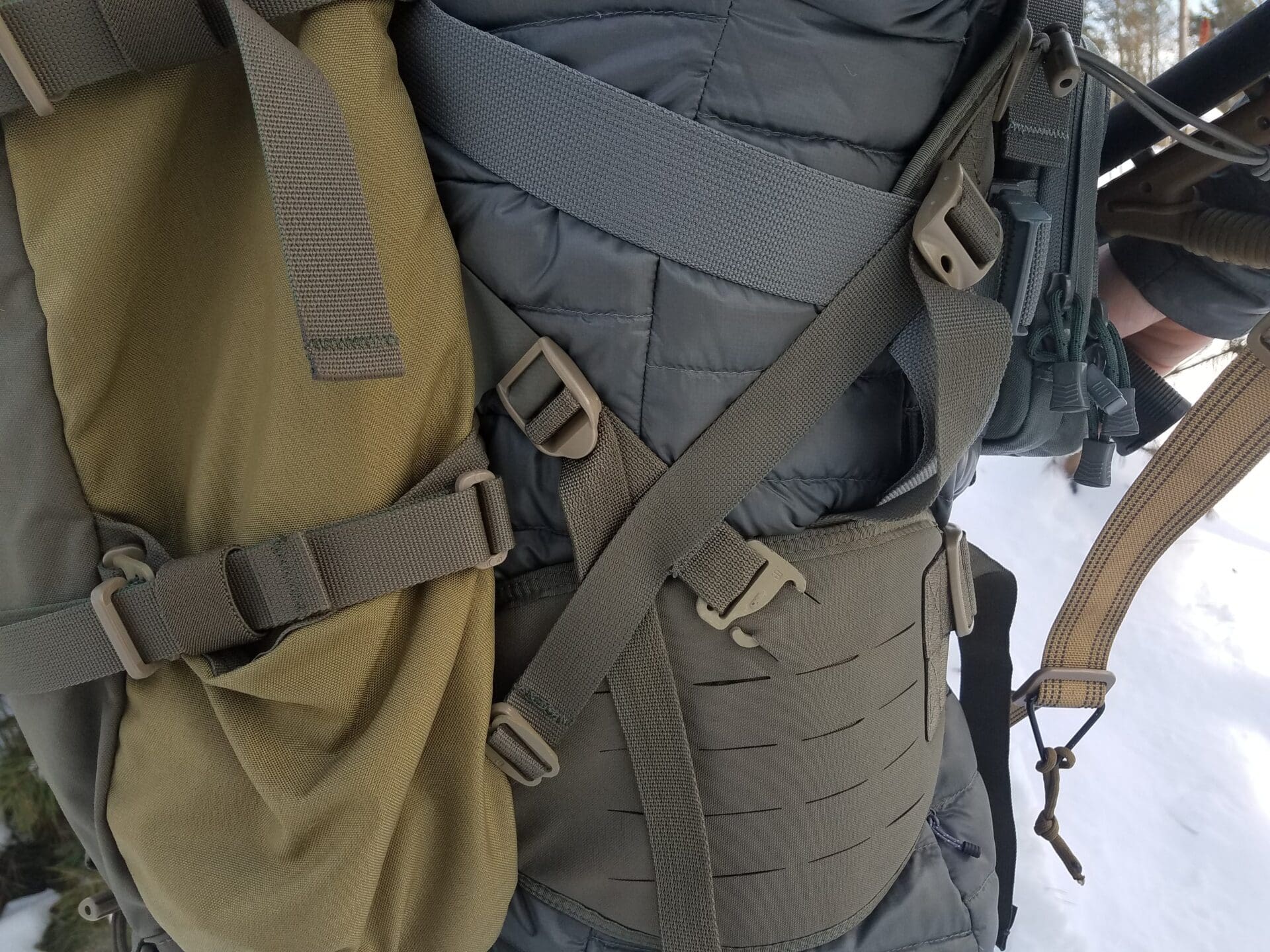
The system doesn’t stop there. When you put it on first, the Heavy Recon is able to integrate into the Umlindi by means of D-Rings and lift straps. The kit bag links to the shoulder straps of the pack and the load on your chest is magically gone.
It’s difficult to describe how well this pack carries unless you compare it to other gear that’s not as well designed. . I’ve carried heavy packs for both competition and work and nothing to date can come close as far as comfort is concerned.

I like to maximize the utility of all of my gear. The kit bag is peerless in terms of usefulness while hunting. It allows instant, easy access to gear and stays out of the way when not needed. It’s also excellent for hiking, (though it looks a little out of place in a public setting).
The Umlindi, however, fits right in. I really enjoy the fact that it looks like a regular backpack. I say ‘regular’ because there is definitely a line where ‘tactical’ begins and sanity ends. While on the large side for EDC use, I’ve made the Umlindi my daily carry pack and it has shined in that role.
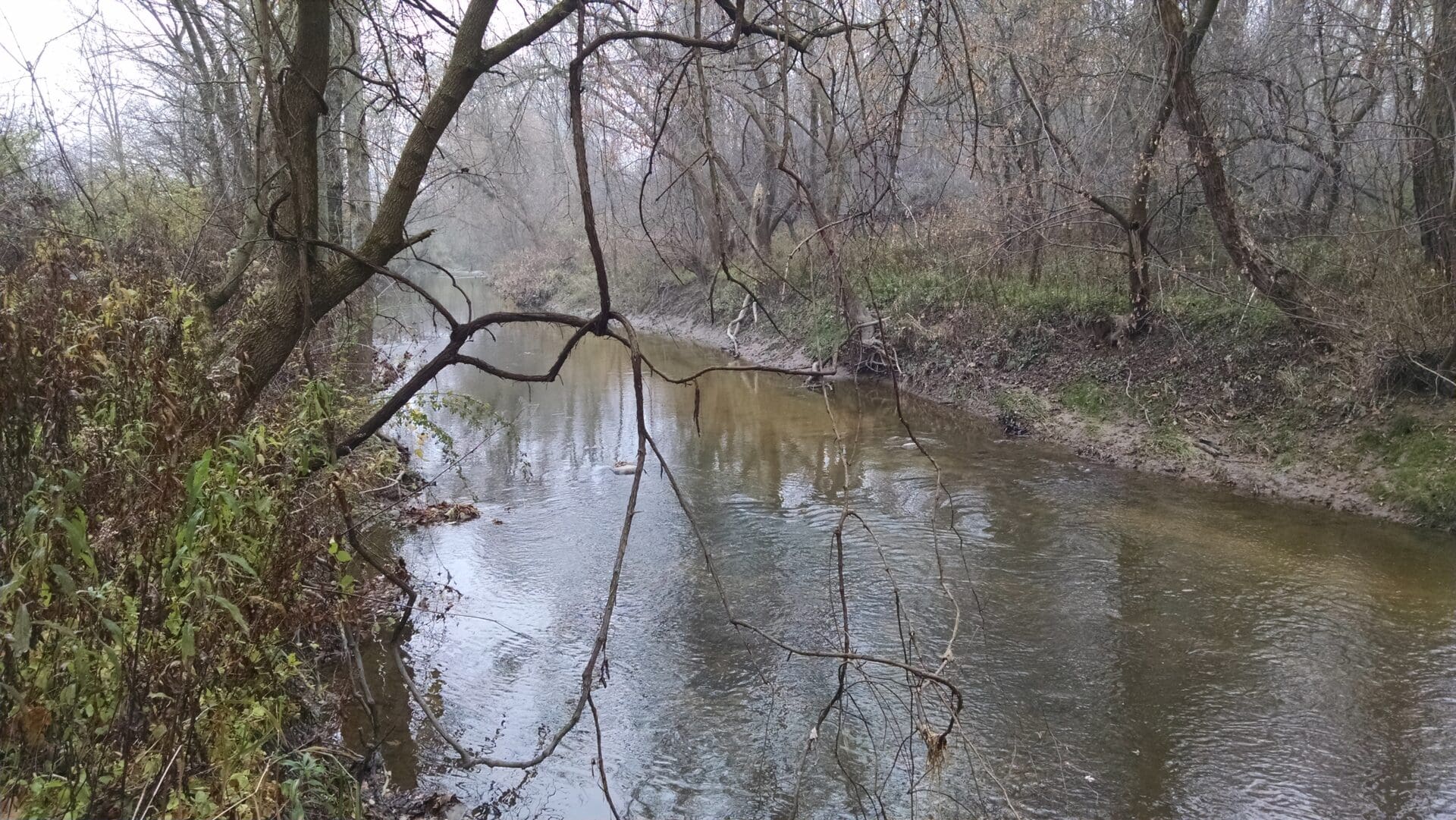
To put this gear though its paces, I did everything I could with the Umlindi, logging over 100 miles of hiking and walking in Michigan’s late fall and winter with it. I used it in my training regimen and varied the weight regularly. It saw loads as heavy as fifty pounds and as light as a Jimmy Johns #10 and a couple beers.
I’ve had other packs literally fall apart after only a few hikes, but the Umlindi is still like new, even after slips and spills into water and dirt. It just keeps going.

The pack also served as my range bag, tool bag, duffle for visiting relatives, and catchall/bookbag at my job. At no point was the pack unable to evenly handle the load or did it get uncomfortable. I’ve put this pack through a wide range of normal to strenuous use and it hasn’t stopped surprising me. When the weather breaks here in the Wolverine State, I plan to bike and trail ride with both the Kit Bag and Umlindi.

At this point I’d list the gear’s negatives, but friends, I frankly couldn’t find a darned thing that I wasn’t happy with. And I tried. My other pack, an Eberlestock GS2, gets heavy after a couple miles, but is great for toting a rifle. It is, however, a military pack and isn’t necessarily meant for daily commutes. Still, operators have to operate so I won’t judge.
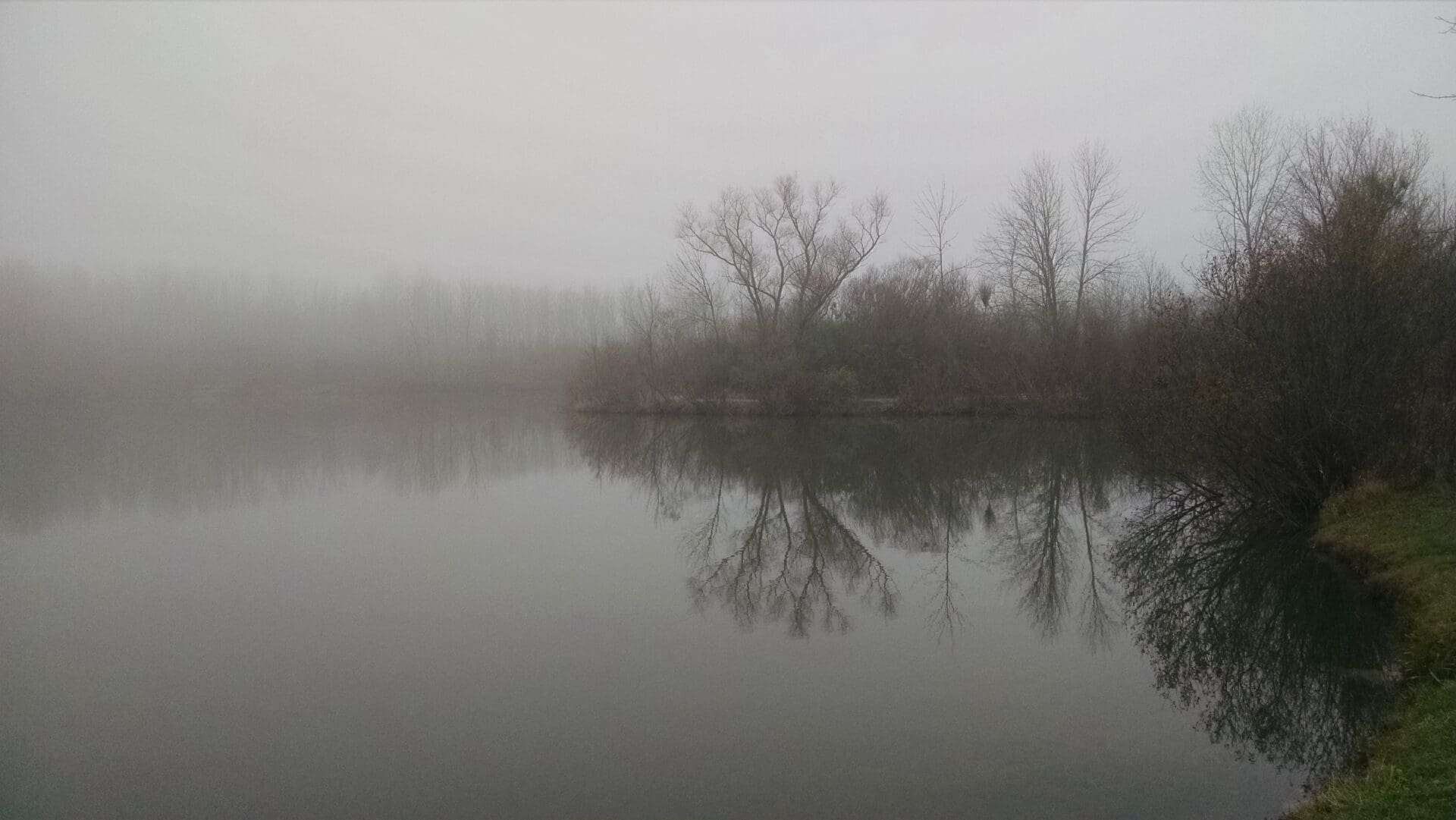
If you find yourself in the market for a better way to carry your gear — whether in the field or on your daily commute — look no further than Hill People Gear. Dealing with them is an experience in old-school charm and, to top it off, they are a family-owned company that makes their products in Western Colorado.
Their gear is of a substantially higher quality than foreign-made gear I’ve tried and it shows in their attention to detail. You may notice that their prices are shockingly reasonable for top-of-the-line American-made goods. Retail on the Heavy Recon Kit Bag is $106.95 as of this writing and $204.60 for the Umlindi. Considering the vast array of uses these items have, the cost is well worth the benefits.
Specifications: Heavy Recon Kit Bag
Weight: 1.40 lb
Length: 1.50 in
Width: 11.50 in
Height: 7.50 in
Volume: 129.38 in3 (approx. 2 liters)
Specifications: Umlindi Backpack
Weight: 2.82 lb
Length: 6.50 in
Width: 11.00 in
Height: 19.00 in
Volume: 1358.50 in3 (approx. 22.25 liters)
Ratings (out of five Stars):
Design: * * * * *
Both the Umlindi pack and the Heavy Recon are extremely well thought-out with no wasted space or non-functional features.
Ergonomics: * * * * *
There isn’t a pack that I’ve worn that has carried as well for as many miles as the Umlindi. When combined with the Heavy Recon and belt, the system sets the standard for comfort.
Modularity: * * * * *
Not only are Hill People Gear packs and gear compatible with each other, but they’re able to accept anything from pouches to bladders and then some. I like that the Umlindi can transform from hiking pack to computer bag in seconds.
Value: * * * * *
You may think I’m crazy for giving a $200+ pack and a $100 chest rig five stars for value, it makes sense when you realize that this three-piece kit can cover all but the last 1% of imagined uses. It’s hard to find gear this good and versatile at any price.
Quality: * * * * *
If you haven’t gathered by now, I’m seriously impressed with both Hill People Gear’s products. The seams alone show great attention to detail. I was unable to find a flaw or popped stitch anywhere on any of the three items.
Overall: * * * * *
Not to gush, but five stars isn’t really enough here. For many this set-up will be the holy grail of gear offerings. Just like the grail (in the Indiana Jones version, at least), simplicity is often passed over for ostentatious display and utility is lost in the process. Not so here.




looks like a winner. thanks!
They make great jackets as well (Wind Cheater).
Question: not very “operator” but I am looking to replace a laptop bag for work–and I have a fetish for gear—does the backpack have a laptop sleeve
If memory serves the Lindi does not have a sleeve that could be used for a laptop. What you can do is use a panel like HPG’s Attache which attaches nice and snug to the pack. You can also just use a regular stand-alone sleeve and just strap it to the back of the pack with compression straps. I do that all the time on my Ute, either alone or wedged between a compression panel and the main pack. I have also stuck a laptop in the internal hydration/sheet pocket on the Ute but it’s not my preference.
I’ve used a HPG chest bag & their smaller, Tarahumara day pack for SAR work for a couple of years now. I’ve absolutely brutalized this equipment; it’s been rained on, snowed on, dropped in creeks, mud holes, bounced down rock faces on the end of a rope, thrown in trucks, UTV’s & car trunks. There is still not a single thread broken, a zipper failure, a rip, a tear…nothing.
It’s starting to look a little….”tired” but it’s a LOONG way from retirement. The shoulder harness HPG uses on all their packs is the single best harness I have ever used, period. There are a LOT of people who have taken advantage of them selling the harness and replacing the ones on other manufacturers bags with this one. Once you get it dialed in to your body shape, you can truly carry bout 20% more weight, 20% further, just because it fits so well
My Recon Kit Bag has been stellar. one of the best pieces of gear I have ever owned.
Nice review.
I currently run a HPG runner’s kit bag for hiking/jogging/biking/climbing/pt. This rig is awesome and makes it super easy to carry handgun wherever my training takes me. The runners version has an elastic band that keeps the pack snug to your chest when running and prevents the bag and it’s contents from bouncing around. This has been the best solution so far for running/ working out while carrying. Awesome company and awesome gear.
Large ALICE ruck sack with frame, $75.
Forgoing the hype and saving both money and time, priceless.
External frame with skinny simple little straps, heavy canvas/nylon duck cloth, limited adjustment & stabilization, and no lumbar support at all . I had a miniature ALICE style pack by Kelty as a brat in Scouts; God, I hated that thing, most uncomfortable burden imaginable. First time I tried an internal frame it was so much better in every way I couldn’t believe it, and I’ve never looked back. I know they can theoretically be tuned up nice, but usually they’re huge, heavy, and uncomfortable in practice. I have huge respect for guys being tough enough to use them in the service, but I also understand why so many have back, shoulder, and nerve issues when they were used with heavy loads, and why practically everyone has left that design behind apart from the very few instances where you truly need the real estate & frame to carry 100lbs of junk up a mountain.
I am still in the service. I prefer to carry my old issued ALICE pack over my issued MOLLE ruck, as well as my Marine Corps ruck with internal frame. All are tough as nails but I loathe the new Army crap.
Yes, carrying loads over 100 lbs will break a man down.
As with everyone here, this is only my opinion and YMMV.
Quick question for folks familiar with the Hill People ‘approach’ to back pack…packing;
It looks like they’re really big on secondary compartments/modules that snap in to the main unit to facilitate organization/attachment/etc. Does this convenient modularity come at a significant cost of bulk or weight (I already know it comes at a monetary cost, lol)? Considering my current load uses like three stuff-sacks to organize everything inside a single big rucksack compartment for a couple-day outing, all those sheets of PALS webbing, zippered organizer pouch units, layers of pockets, PALS belt accessories, and so on look like they’d be really heavy & big. Either that, or the usable volume is a lot less than I’d expect because the products do look nicely low-profile.
I realize this approach likely stems from military practice, where configurability is paramount because of the diversity of gear loadouts (and a lot of it needs to be accessed throughout the day), but I’m unsure about buying in to that mindset when I know it’ll be the same dozen or so items in the same places accessed at the same times every day for my backpacking needs. They sure do know how to make nice looking packs, though.
I’ll be brutally honest here but you need to keep in mind that I have some specific uses for what I’m looking at here, namely long range, extended trips to BFE.
I’m finishing up a review for a Slumberjack pack which I will submit to TTAG. I shopped around A LOT before I bought it and HPG was in the running right up until the end. Their stuff is rock-fucking-solid, no doubt. From what I’ve handled it’s not excessively heavy or bulky. It’s the price that absolutely kills me. Yes, modular as all get-out that modularity costs a lot. It’s $20 here, $37 there, $65 over here and then $100 for a belt to go on the pack… and it adds up fast. You rapidly end up talking hundreds of dollars, often on top of the original pack.
I had the same problem with Kifaru but to a much greater extent. Yes, badass packs, really truly good stuff. However, the packs are sold separately from the frames and the cheapest frame they offer is $318. Meanwhile the cheapest pack they sell to go on that frame is $260 and most of the nice ones that have the features you want for hunting or extended backpacking are $400-$500… and you’re probably going to want one of the nicer frames anyway which are close to $400 by themselves.
Now, HPG isn’t on that level of expense, but in a lot of the pictures featured online (not this review) those packs have a lot of extras attached to them. Cool as hell but you’re not touching that set up for $200 or even close to $200. Double that at least.
Now I’m not one who shies away from a product because it’s expensive but I always want to know WTAF I’m getting for my dollars and at a certain point I write things off because the cost difference isn’t buying me significantly more of anything that matters to me.
So I would say this: IME, not bulky or heavy unless you’re comparing it to serious Alpinism packs at 3-5x the price of HPG but to get all the cool features be prepared to open your wallet pretty wide. Personally, I couldn’t justify the extra expense just because HPG was cool. YMMV.
Sounds like an exercise in wallet-burn unless you know exactly what you want, which there’s no way I can since I’ve never used packs that work this way. That’s good to hear about the bulk; I’ve made some gear for myself with MOLLE webbing on it, and man it gets heavy fast; zippers, too. Seeing all those layers of fabric on top of each other and plastic divider panels & webbing & pockets looked kind of painful. HPG definitely has some cool ideas as far as the U-shape shoulder strap assy that lets you hang a variety of frames off it, and of course the chest-bag counter balance that’s sort of their thing. That stuff looks ungodly hot in Texas heat/humidity (I notice most pics are in cold weather), but I suppose the rig that uses the chest bag as part of the harness vs. sitting underneath it may not be so stifling. Would be nice to have water weight up front for a change.
I imagine if I’d served in the infantry that I’d be able to wrap my head around this stuff a bit easier; rucksacks are more my speed (at least I’m not external-frame antiquated anymore, though). And the point of backpacking is kind of to not spend a crapload of money, otherwise I’d be having a Sherpa carry my shit, lol. I’ll consider these guys over the toolbags at REI once their stuff wears out, though.
Josh Wayner may disagree with me, and again, keep in mind that I’m looking at this as an extended trip type of bag, not a day bag, carry-on travel bag or even a 3-day bag BUT I based my numbers off two bags, the one he tested ($220) and the Ute ($400) end up costing a mint.
Neither came out as workable for my uses for under $600 and really the Ute was the choice because of it’s size.
Like I said, the modularity of HPG bags is AWESOME but you pay for it. IMHO, it’s cheaper to buy another bag or two for other uses but that’s just MHO. OTOH, their “Attache” messenger bag, at $140 seems like a steal considering what you’re getting. I would say the same of their other stuff if the base model is good enough or doesn’t need a lot of upgrades for what you’re doing.
Also keep in mind that to a large extent with this kinda stuff you get what you pay for and, as I said in my OR, HPG stuff is rock-fucking-solid (and yes, in my book that’s a step up from rock solid, not just a term I’m throwing around).
All that said, your first sentence sums it up. You can burn a lot of money on this brand buying stuff you don’t need if you can’t put your hands on it.
As someone that just started using HPG bags, it really just depends on how you like to pack. Their modularity to is to add to the experience but isn’t needed to pack out. The bags are designed really as a large dump pouch. You can simply throw everything into the bag and go—no need for pouches and accessories. That said, the pouches are amazing for organization and an “at-arms-reach” approach to packing and hiking.
The nice thing is that the fabric is a light-weight rest durable 500D Cordura-type nylon that seems softer and more practical than most military materials seen on the market.
To date, I use the modular system of the following and its amazing:
1. Umlindi / UTE Pack (have both – one for day hikes and one for long backcountry excursions).
2. The 2016 Butt Pack (Doubles as both Butt Pack when placed on Prairie Belt, as well as top “Brain” of pack(s). It’s nice to pull off and add to the belt for short day hikes away from camp.
3. Prairie Belt
4. A few of the small pouches meant to be added on to the belt (good place of snacks, GPS, and some other odds and ends.
In all, if it helps, I just went through major spinal surgery with a fusion of my L4-L5 and L5-S1. These packs were meant as insurance as to not hold major loads above my surgical point, As someone that has gone through countless bags, spent my life in the wilderness, these packs and accessories are by far the best I’ve every seen.
Hope that helps answer your question 🙂
The runners kit bag is the single best solution for carrying while recreating I have ever found. Enough room for wallet, phone, keys, Skoal in front pocket, almost instant access to my friend Roscoe in the rear pocket. It doesn’t move around, and it is reasonably low profile. I do wish it came in rad bro/brah colors for a less tacticool look.
Boob window. Google it.
I’ve seen the chest bags in the past but I’ve never been sure how great they are in use, I will have to put a molle bag on my vest there and see how it flies.
Hill People Gear seems like Spec Ops Brand, my favorite source for American-made, bombproof molle gear. I have two packs and a few pouches from them and they’re all crazy tough. I would trust that gear through the apocalypse. The owner of the company got back to me a few minutes after I sent an email once late on a weeknight about an idea I had, too. I’m gonna check out Hill People Gear though, Spec Ops makes great stuff but they’re very conventional about the pouches, all standard military and LE sizes.